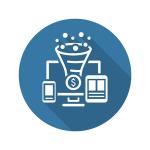How To Get Started With Prescriptive Sales



While many organizations are becoming more excited about the possibility of predictive sales, where intelligent software helps teams essentially see into the future of how customers will be spending their budget, prescriptive sales ensures the process of selling doesn’t break down along the way.
It’s famously difficult to read many doctors’ handwriting, but when we’re given a prescription there’s usually the reassurance that whatever ails us may soon be over. We know that we can hand in the prescription to the pharmacy, get medicine and take it to feel better. Prescriptions in health care are very effective because everyone knows what to do. Prescriptive sales works much the same way.
While many organizations are becoming more excited about the possibility of predictive sales, where intelligent software helps teams essentially see into the future of how customers will be spending their budget, prescriptive sales ensures the process of selling doesn’t break down along the way. It’s a way of codifying what really works within a given company’s customer set, a particular geography or even within a large account.
Especially when reps are new or inexperienced, prescriptive selling is a way for large organizations to ensure that nothing gets missed and errors are minimized. Small and medium-sized businesses could get the same benefits, however, and in some cases even greater benefit because they tend to have fewer feet on the ground.
This is just one way prescriptive sales could begin in your company.
Take Time With The Diagnosis
The only time we’re leery of taking a prescription from a doctor is when we feel we’ve been rushed in and out of their office without really being heard. Prescriptive selling is not about shoving a list of priorities at a rep and then hurrying them on their way, either. It involves talking to both the worst and best performers to ensure sales stay as healthy as a possible. Try these exercises:
- Act it out: Have reps role-play their typical pitch or discussion with customers when they get in front of them. Take pauses where there’s a teachable moment that could improve the outcome.
- Take it to the white board: Use quick notes or bullet points to break down the transition from lead generation to that first phone call or meeting, the follow-up and anything that happens in between. Talk about typical timelines and anything unexpected that tends to come up.
- Show, don’t tell: Demonstrate the sales process as you, the manager, understands it. Encourage others to interrupt with examples of what happens in the “real world” versus how they’ve been trained.
In all these cases, reserve actually prescribing anything until you’re sure reps have given all the useful feedback they possibly can.
Put Away The Paper
Doctors still scribble prescriptions by hand and tear them off small pads, but that’s not nearly as effective in a sales environment. Prescriptive selling should take advantage of the digital distribution channels available to everyone from SMBs to large enterprises. Some of the examples you should be thinking about include:
- Intranet/Internal Community: Even if you don’t have a full-fledged web site that’s only available to employees, there are plenty of free and simple ways to share documents online. Offer your sales prescription in brief bullet points that can be read as easily on a mobile device as a desktop PC.
- E-mail: You probably already offer some form of e-mail marketing to nurture customer demand. Treat prescriptive selling as the basis for a regular e-mail newsletter to employees where you can talk about recent wins and tie them back to the steps in your process.
- Social: You probably don’t want to share the secrets of your prescriptive sales process on Twitter or LinkedIn, but there are plenty of similar tools available for teams within companies where prescriptive selling can become a conversational coaching process.
Dig Deeper Into Data
Prescriptive selling shouldn’t sound abstract or theoretical to reps. If it does, they’re far less likely to embrace the right priorities or follow what they’ve been instructed to do. The best solution for that is leveraging real-world examples of where the prescriptive sales strategy is already resonating. This is where your CRM will really start paying for itself:
- Deconstruct your last big customer win with the team. Don’t merely show them the steps that lead to a deal getting closed. Pull up the relevant information from your CRM solution about your customer that helped inform those steps.
- Weave in prescriptive selling into your next CRM training or refresher session. Map out where imputing more data or making sure it’s available to a wider pool will help the organization as a whole.
- Play “If This, Then That.” If a rep comes across a customer record in CRM that has gathered dust for some reason, for example, what should their next step be — flagging it to the manager, making a proactive phone call, sending an e-mail or looking for more background research? This will help define how you want CRM to create value.
Follow-Up (And Follow Through)
Even when we get a prescription from the doctor, we know we’ll often be back at some point to ensure the remedy worked as was hoped. Similarly, prescriptive selling should be reviewed as often as makes sense given changing customer situations or changes in your overall market. And of course, adjust what you’re prescribing based on what you hear:
- Play “Wait, But Why?” Even when prescriptive selling is used, reps may be more likely to know what they’re supposed to do than the reasoning behind it. Walk through some recent attempts at closing a deal to go over your rationale.
- Compare with competitors: Often over the course of selling reps will learn a bit about how other firms are approaching the same customers, the steps they stick to and so on. While this information may not always be accurate, discuss what you can learn from rivals and how it might make you rethink your own approach.
When it works well, prescriptive selling doesn’t have to be a top-down way of working. Instead, what’s prescribed can be the result of a team that’s actively focused on ensuring the best way to do things is shared by all.
Check out more tips to increase your sales performance with Salesforce’s free eBook:























